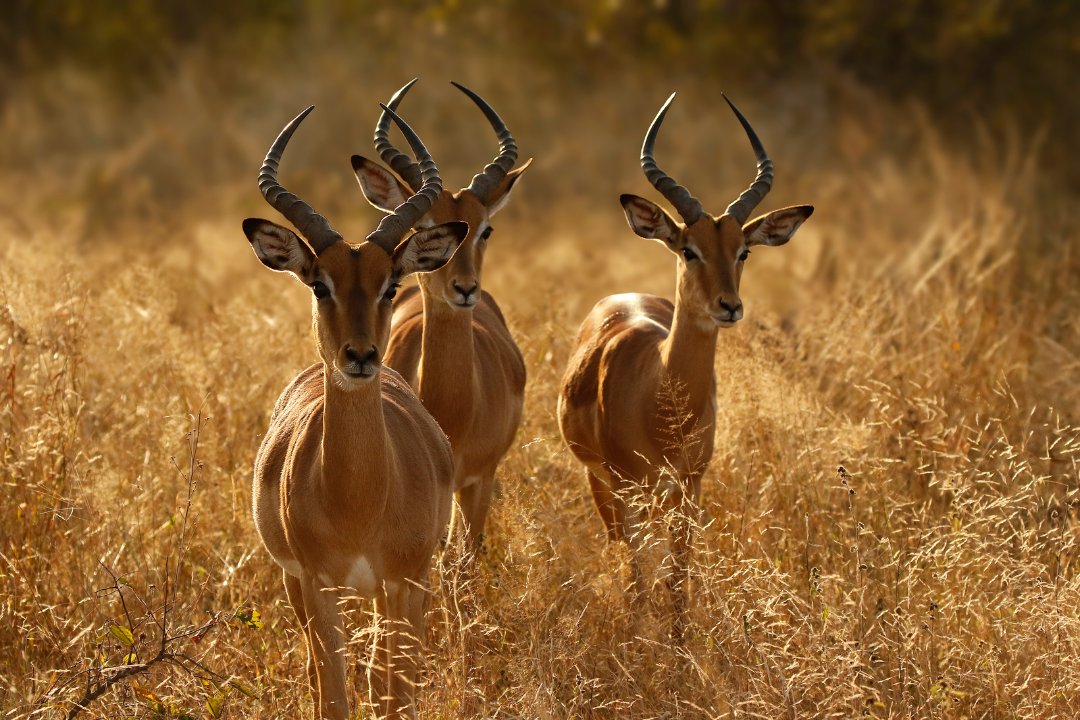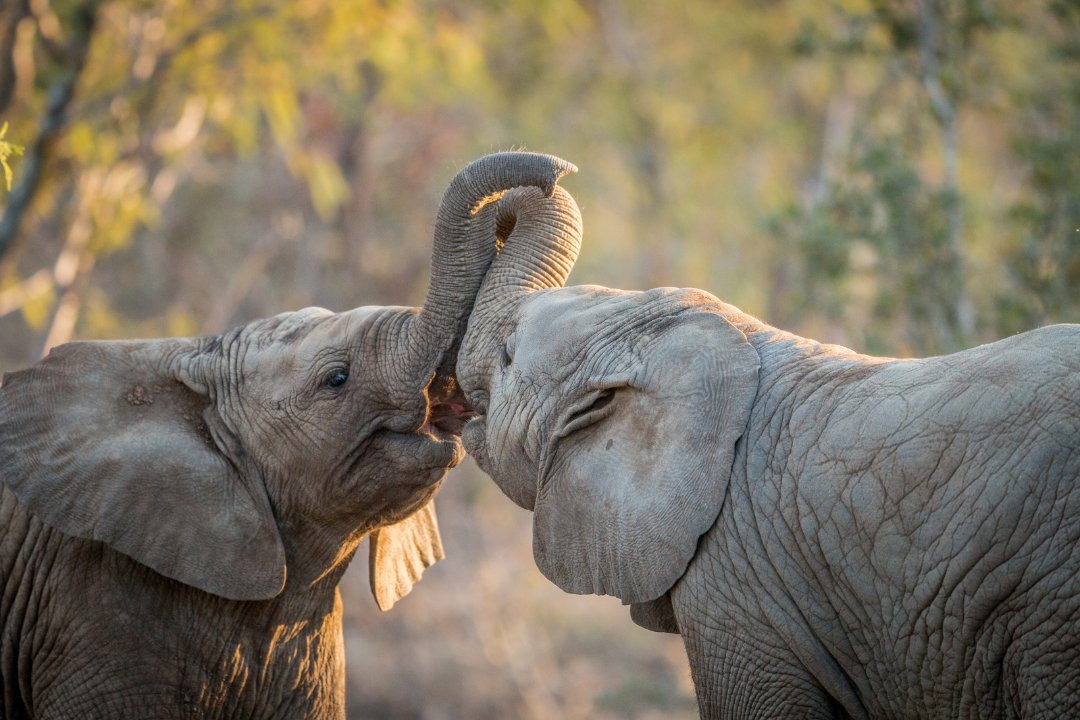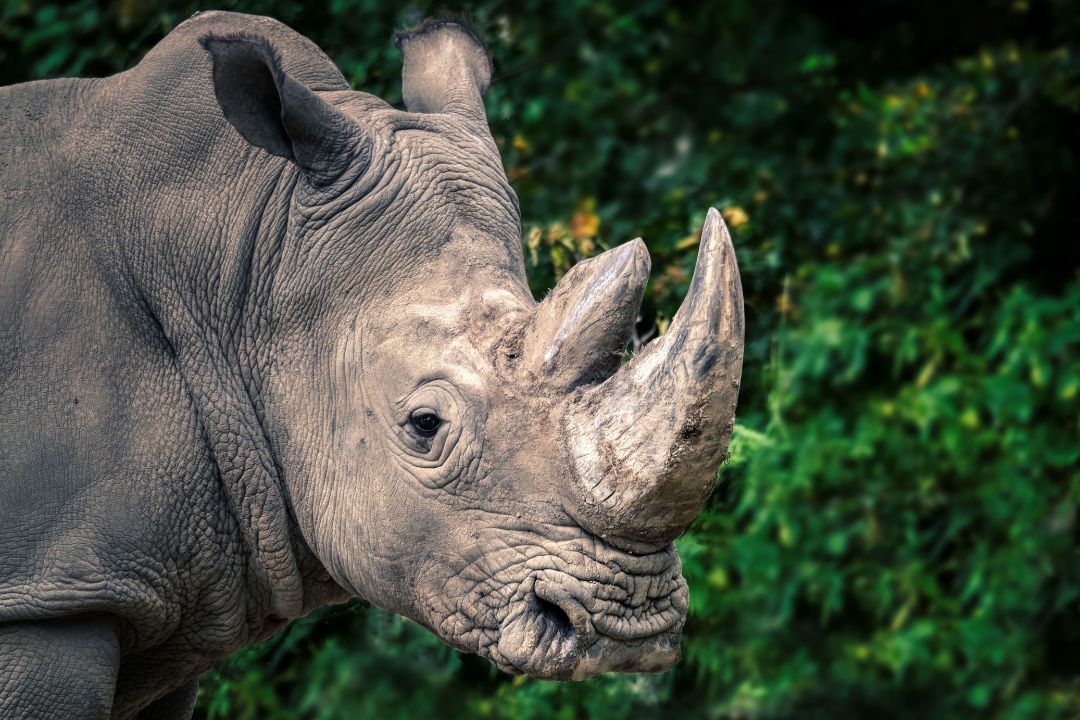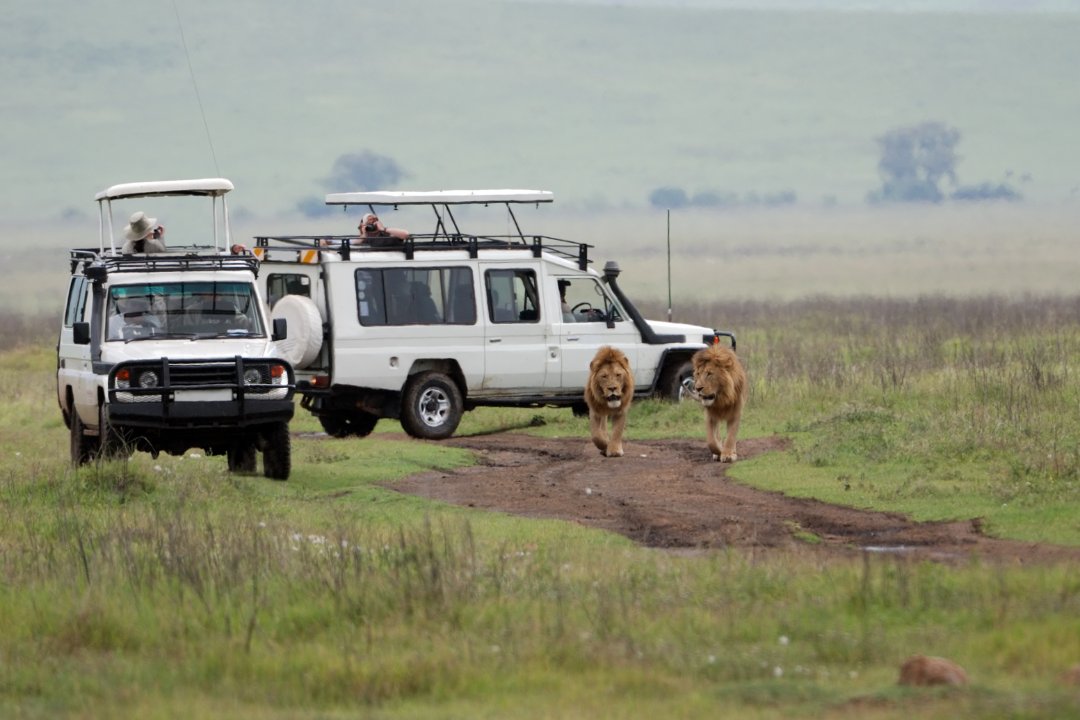Ngorongoro Crater, located in northern Tanzania, is one of the most extraordinary and iconic natural wonders in the world. Formed around three million years ago when a giant volcano exploded and collapsed, the crater is now the largest inactive and unfilled volcanic caldera. Measuring about 20 kilometers in diameter and 600 meters deep, it spans an area of approximately 260 square kilometers. The crater’s rich volcanic soil and diverse habitats, including grasslands, swamps, lakes, and forests, create a unique micro-ecosystem that supports a wide variety of wildlife. Declared a UNESCO World Heritage Site, the Ngorongoro Crater is often referred to as the “Garden of Eden” due to its abundant and easily visible wildlife populations.
Within the crater’s confines, visitors can witness a remarkable density and diversity of animals, making it one of the most sought-after safari destinations in Africa. The crater floor is home to the Big Five—lions, elephants, buffalo, leopards, and the critically endangered black rhino—as well as a myriad of other species such as zebras, wildebeest, hippos, and over 500 bird species. The permanent water sources in the crater, such as Lake Magadi, ensure that wildlife remains in the area throughout the year, providing exceptional game viewing opportunities. In addition to its natural beauty and wildlife, the Ngorongoro Conservation Area also holds cultural significance, being home to the Maasai people, who coexist with the wildlife and continue to practice their traditional pastoral lifestyle. This unique blend of geological, ecological, and cultural elements makes Ngorongoro Crater a must-visit destination for nature enthusiasts and those seeking an unparalleled safari experience.




1. What is the best time to visit Ngorongoro Crater? The Ngorongoro Crater can be visited year-round, but the best time is during the dry season from June to October. This period offers the best wildlife viewing as animals gather around water sources. The wet season, from November to May, brings lush landscapes and excellent bird watching, though some roads may be challenging to navigate.
2. How do I get to Ngorongoro Crater? Ngorongoro Crater is accessible by road and air. Most visitors fly into Kilimanjaro International Airport or Arusha Airport and then drive to the crater. The drive from Arusha takes approximately 4-5 hours. There are also airstrips in the Ngorongoro Conservation Area for charter flights.
3. What accommodation options are available near Ngorongoro Crater? A variety of accommodations are available near the Ngorongoro Crater, including luxury lodges, tented camps, and budget campsites. Many lodges offer spectacular views of the crater from their locations on the rim, providing easy access to the crater floor for game drives.
4. Is it safe to visit Ngorongoro Crater? Yes, it is generally safe to visit Ngorongoro Crater. However, visitors should follow the advice of their guides and adhere to park rules. Health precautions, such as vaccinations and malaria prophylaxis, are recommended.
5. What wildlife can I expect to see in Ngorongoro Crater? The Ngorongoro Crater is home to a diverse range of wildlife, including the Big Five (lions, elephants, buffalo, leopards, and black rhinos). Other species commonly seen include zebras, wildebeest, hippos, hyenas, jackals, and a variety of bird species. The crater’s permanent water sources ensure that wildlife is present year-round.
6. Do I need a visa to visit Ngorongoro Crater? Yes, most visitors will need a visa to enter Tanzania. Visas can be obtained upon arrival at the airport or in advance from Tanzanian embassies and consulates. It is advisable to check the latest visa requirements before you travel.
7. What should I pack for a trip to Ngorongoro Crater? Pack light, breathable clothing in neutral colors, a wide-brimmed hat, sunglasses, sunscreen, and insect repellent. Binoculars and a good camera are essential for wildlife viewing. Sturdy walking shoes and a warm jacket for early morning and evening game drives are also recommended.
8. Are there any cultural experiences available near Ngorongoro Crater? Yes, visitors can engage in cultural experiences with the Maasai people who live in the Ngorongoro Conservation Area. Many tours offer visits to Maasai villages where you can learn about their traditions, see traditional dances, and purchase handmade crafts.
9. What activities are available in Ngorongoro Crater? Activities in Ngorongoro Crater include game drives, guided walking safaris, bird watching, and visits to Maasai villages. Some lodges also offer cultural tours and excursions to nearby attractions such as Olduvai Gorge, a significant archaeological site.
10. How does Ngorongoro Crater contribute to conservation? Ngorongoro Crater plays a vital role in conservation by protecting a diverse array of species and habitats. The Ngorongoro Conservation Area is involved in various initiatives to combat poaching, preserve endangered species, and promote sustainable tourism. Conservation fees paid by visitors support these efforts and help maintain the area’s ecological and cultural integrity
For questions or booking inquiries, call +255 672 827 822 or
contact us.
What people say about Tarangire National Park in Tripadvisor
 Bean G2024-07-20Memorable Safari Experience with Wild Rhythm Adventure Our 5-day safari with Wild Rhythm Adventure, led by Ian, was simply incredible. Ian's expertise and passion for wildlife made every moment unforgettable. From thrilling game drives to stunning sunsets, it was a journey of a lifetime.I highly recommend Wild Rhythm Adventure to anyone seeking an authentic safari experience. Their professionalism, dedication, and passion for wildlife conservation make them a standout choice for exploring the wonders of Africa. Thank you, Ian and the team, for an unforgettable journey!
Bean G2024-07-20Memorable Safari Experience with Wild Rhythm Adventure Our 5-day safari with Wild Rhythm Adventure, led by Ian, was simply incredible. Ian's expertise and passion for wildlife made every moment unforgettable. From thrilling game drives to stunning sunsets, it was a journey of a lifetime.I highly recommend Wild Rhythm Adventure to anyone seeking an authentic safari experience. Their professionalism, dedication, and passion for wildlife conservation make them a standout choice for exploring the wonders of Africa. Thank you, Ian and the team, for an unforgettable journey! softwareman p2024-07-10Marangu route with Wild Rhytm I recently completed the Marangu route on Mount Kilimanjaro with Wild Rhythm Adventures. The experience was exceptional, thanks to the expertise and dedication of our guide, Johnson. The organization and support provided by Wild Rhythm Adventures ensured a safe and memorable trek. Johnson's knowledge of the terrain, coupled with his encouraging demeanor, made the challenging journey enjoyable. I highly recommend Wild Rhythm Adventures for anyone looking to conquer Kilimanjaro.
softwareman p2024-07-10Marangu route with Wild Rhytm I recently completed the Marangu route on Mount Kilimanjaro with Wild Rhythm Adventures. The experience was exceptional, thanks to the expertise and dedication of our guide, Johnson. The organization and support provided by Wild Rhythm Adventures ensured a safe and memorable trek. Johnson's knowledge of the terrain, coupled with his encouraging demeanor, made the challenging journey enjoyable. I highly recommend Wild Rhythm Adventures for anyone looking to conquer Kilimanjaro. Геннадия Р2024-07-09Truly Unforgettable Adventure Wild Rhythm Adventures provided an exceptional 2-day safari experience that exceeded all expectations. From the moment we departed, every detail was meticulously arranged, ensuring seamless transitions between parks and maximizing our time with wildlife. Lake Manyara National Park showcased its famed tree-climbing lions and diverse birdlife, while Tarangire National Park offered unforgettable encounters with elephants and stunning baobab trees. The knowledgeable guides made each game drive informative and exciting, enhancing our understanding of the ecosystem. Accommodations were comfortable, meals delicious, and the overall service impeccable. A truly unforgettable adventure, highly recommended for anyone seeking a glimpse into Tanzania's natural wonders.
Геннадия Р2024-07-09Truly Unforgettable Adventure Wild Rhythm Adventures provided an exceptional 2-day safari experience that exceeded all expectations. From the moment we departed, every detail was meticulously arranged, ensuring seamless transitions between parks and maximizing our time with wildlife. Lake Manyara National Park showcased its famed tree-climbing lions and diverse birdlife, while Tarangire National Park offered unforgettable encounters with elephants and stunning baobab trees. The knowledgeable guides made each game drive informative and exciting, enhancing our understanding of the ecosystem. Accommodations were comfortable, meals delicious, and the overall service impeccable. A truly unforgettable adventure, highly recommended for anyone seeking a glimpse into Tanzania's natural wonders. naomie m2024-06-07Amazing A serious agency, i highly recommend. During these 3 days in Tanzania, Hammad listened to our needs and expectations, we were able to discover wonderful places. Thank you again for the professionalism of the agency!
naomie m2024-06-07Amazing A serious agency, i highly recommend. During these 3 days in Tanzania, Hammad listened to our needs and expectations, we were able to discover wonderful places. Thank you again for the professionalism of the agency! Abeid J2024-05-31incroyable experience We traveled with Wild Rhythm Adventures, and it was wonderful! Our guide, Hussein, was excellent—highly knowledgeable about Tanzania, adept at locating wildlife, efficient on the roads, and fluent in French. Our accommodations were amazing, and the itinerary was perfect. We highly recommend Wild Rhythm Adventures!
Abeid J2024-05-31incroyable experience We traveled with Wild Rhythm Adventures, and it was wonderful! Our guide, Hussein, was excellent—highly knowledgeable about Tanzania, adept at locating wildlife, efficient on the roads, and fluent in French. Our accommodations were amazing, and the itinerary was perfect. We highly recommend Wild Rhythm Adventures! jesca m2024-05-31*Exceptional Safari Experience with Wild Rhythm Adventures* Last year, I had the pleasure of experiencing a two-day safari in Tanzania with Wild Rhythm Adventures, exploring the incredible Tarangire and Ngorongoro. It was an unforgettable adventure. The safari was meticulously organized, and every detail was taken care of, ensuring a seamless and enjoyable experience. Our guide Hasheem, was knowledgeable, friendly, and passionate about the wildlife and the environment. They took us to some of the most stunning spots, where we witnessed an incredible array of animals and breathtaking landscapes. Wild Rhythm Adventures provided excellent service from start to finish. The accommodations were comfortable and well-chosen, adding to the overall enjoyment of the trip. I highly recommend Wild Rhythm Adventures for anyone looking to explore the beauty of Tanzania through a well-curated safari experience. Their professionalism and dedication to creating memorable adventures truly set them apart. Thank you, Wild Rhythm Adventures, for an amazing journey!
jesca m2024-05-31*Exceptional Safari Experience with Wild Rhythm Adventures* Last year, I had the pleasure of experiencing a two-day safari in Tanzania with Wild Rhythm Adventures, exploring the incredible Tarangire and Ngorongoro. It was an unforgettable adventure. The safari was meticulously organized, and every detail was taken care of, ensuring a seamless and enjoyable experience. Our guide Hasheem, was knowledgeable, friendly, and passionate about the wildlife and the environment. They took us to some of the most stunning spots, where we witnessed an incredible array of animals and breathtaking landscapes. Wild Rhythm Adventures provided excellent service from start to finish. The accommodations were comfortable and well-chosen, adding to the overall enjoyment of the trip. I highly recommend Wild Rhythm Adventures for anyone looking to explore the beauty of Tanzania through a well-curated safari experience. Their professionalism and dedication to creating memorable adventures truly set them apart. Thank you, Wild Rhythm Adventures, for an amazing journey! Albright N2024-05-30Unforgettable Safari Experience with Wild Rhythm Adventures My name is Jimmy, and last year I had the privilege of embarking on a 5-day safari in Tanzania with Wild Rhythm Adventures. Our journey took us through the breathtaking landscapes of Tarangire, Ngorongoro, and the Serengeti, and it was truly a journey of a lifetime. Our guide, Ian, was exceptional. He was not only extremely knowledgeable about the wildlife and environment but also a genuinely nice and personable guy. Ian showed us an incredible array of animals and provided deep insights into the diverse ecosystems we explored. His enthusiasm and expertise made our experience all the more memorable and enjoyable. Wild Rhythm Adventures provided us with outstanding service. The entire team was highly professional, organized, and attentive to every detail. Their dedication to ensuring a seamless and unforgettable experience was evident throughout our trip. We felt safe, well-cared-for, and thoroughly enjoyed every moment. I highly recommend Wild Rhythm Adventures to anyone seeking an extraordinary safari experience in Tanzania. Their expertise, dedication, and warm hospitality set them apart. If you're planning a safari, look no further than Wild Rhythm Adventures! Thank you, Wild Rhythm, for an amazing adventureShowing our latest reviews
Albright N2024-05-30Unforgettable Safari Experience with Wild Rhythm Adventures My name is Jimmy, and last year I had the privilege of embarking on a 5-day safari in Tanzania with Wild Rhythm Adventures. Our journey took us through the breathtaking landscapes of Tarangire, Ngorongoro, and the Serengeti, and it was truly a journey of a lifetime. Our guide, Ian, was exceptional. He was not only extremely knowledgeable about the wildlife and environment but also a genuinely nice and personable guy. Ian showed us an incredible array of animals and provided deep insights into the diverse ecosystems we explored. His enthusiasm and expertise made our experience all the more memorable and enjoyable. Wild Rhythm Adventures provided us with outstanding service. The entire team was highly professional, organized, and attentive to every detail. Their dedication to ensuring a seamless and unforgettable experience was evident throughout our trip. We felt safe, well-cared-for, and thoroughly enjoyed every moment. I highly recommend Wild Rhythm Adventures to anyone seeking an extraordinary safari experience in Tanzania. Their expertise, dedication, and warm hospitality set them apart. If you're planning a safari, look no further than Wild Rhythm Adventures! Thank you, Wild Rhythm, for an amazing adventureShowing our latest reviews